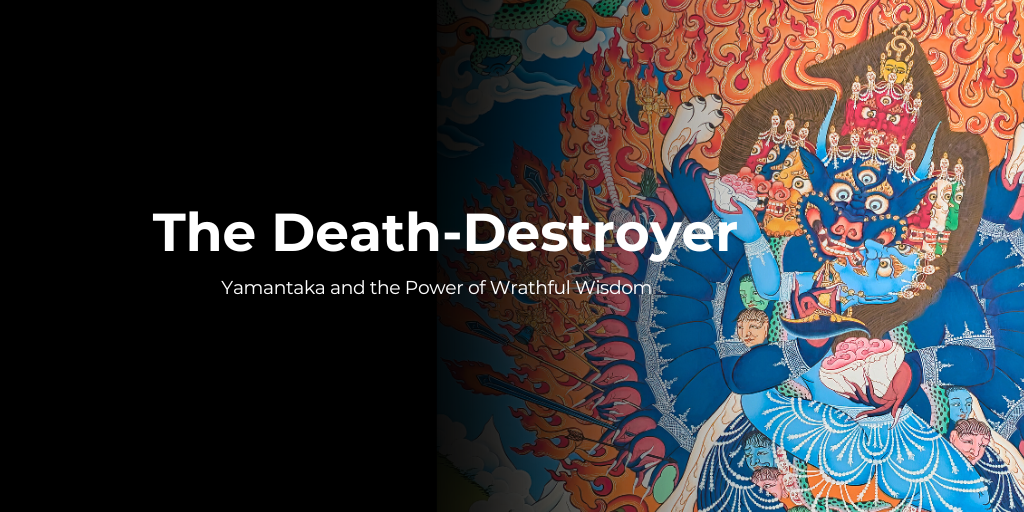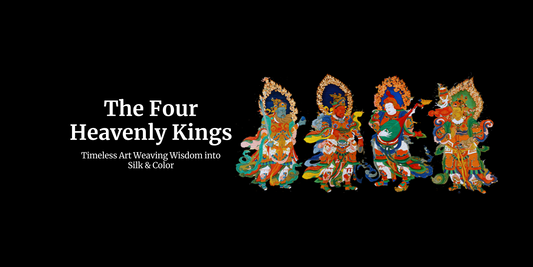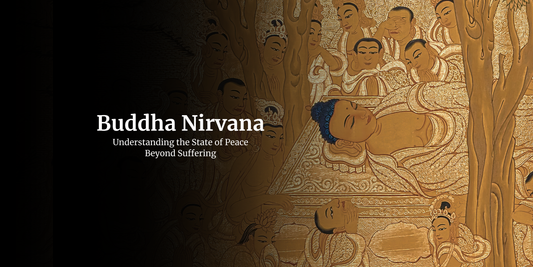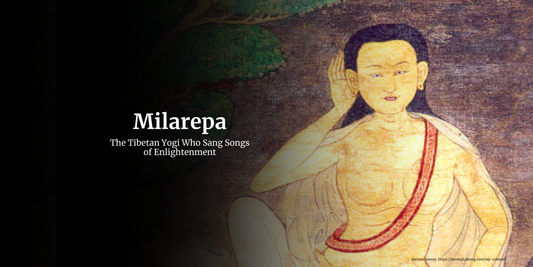- Buddhas Art of Healing
- Thangka Blog | Insights on Tibetan Thangka Art, Symbolism & Tradition
- The Death Destroyer: Yamantaka and the Power of Wrathful Wisdom

The Death Destroyer: Yamantaka and the Power of Wrathful Wisdom
What if the only way to defeat death was through wrathful wisdom? Meet Yamantaka—the fierce Buddhist deity who doesn’t just face death—he conquers it.
With flames, multiple heads, and unstoppable energy, he’s not here to scare you—but to free you. A force of enlightened fury, Yamantaka shatters ego, illusion, and fear itself.
Curious? Let’s uncover the mystery behind this death-slayer and his powerful role in Tibetan Buddhism.
Who is Yamantaka?
Yamantaka is the wrathful wisdom deity who defeated death. He is not a figure of fear but of deep illusion. He is one of the most powerful and complex deities in Tibetan Buddhism.
In Tibetan, Yamantaka is called Jigje, meaning “Vajra Terrifier.” He is known as the “Destroyer of Yama” (the god of death) and embodies wrathful compassion and supreme wisdom.
Despite his fierce appearance, he is a fully enlightened Buddha whose mission is to conquer death, ignorance, and ego. And ultimately guiding practitioners toward liberation.
Mythological Background: Yamantaka Vs Yama
According to Buddhist legends, Yama is the god of death who judges the actions of beings after death. He is usually depicted riding a buffalo, holding the wheel of life, and is responsible for the cycle of rebirth.
However, the myth tells Yama about being highly aggressive—it creates imbalance and fear. In response, Manjushri took on a form more terrible than Yama-Yamantaka and subdued Yama.
This is not just a symbolic victory over death. It represents the transit of death through emptiness and attainment of knowledge. He does not destroy physical death but destroys the illusion of a permanent, ego-based self, which is the true root of sorrow.
Yamantaka in Tantric Buddhism
Yamantaka is central to Anuttarayoga Tantra, the highest class of tantra in Vajrayana. He is especially important in the Gelug tradition, where his practice is used for:
- Overcoming fear of death
- Destroying inner afflictions (anger, pride, attachment, ignorance)
- Purifying karma and achieving enlightenment
- Protecting from black magic, psychic harm, and spiritual obstacles
His practice is typically given through empowerment by a qualified lama and involves visualization, mantra recitation, and advanced deity yoga.
Symbolism and Iconography
Every detail of Yamantaka’s appearance is symbolic and deliberate. Each element serves as a teaching device to awaken the practitioner’s mind.

|
Element |
Symbolism & Meaning |
|
Buffalo Head (Central Face) |
Representing Yama, the god of death, Yamantaka conquers this form to show mastery over death |
|
Nine Faces |
Represents omniscience—awareness in all directions of all dharmas |
|
Main Tamantaka Eye |
The wisdom eye that sees through illusion and duality symbolizes direct insight into ultimate reality |
|
Thirty-Four Arms |
Each arm holds a symbolic weapon to destroy mental afflictions (greed, hatred, ignorance, etc.). |
|
Sixteen Legs |
Trampling demons, gods, and animals, symbolizing the subjugation of ego, pride, delusion and fear |
|
Flaming Aura |
Represents the fire of wisdom that burns away ignorance and samsaric attachment |
|
Weapons (swords, clubs, skull cups, etc.) |
Tools for cutting through delusions and protecting dharma |
|
Crown of Skulls |
Symbolizes the transience of life and ego-death |
|
Garland of several heads |
Represents destroyed egoic thoughts and false identities |
|
Consort Embrace (in some forms) |
Union of wisdom (prajna) and method (upaya)—essential in tantric practice |
|
Standing on Yama and a Bull |
Symbolizes the subjugation of death and karma. Yamantaka dances upon them in victory. |
Yamantaka Mantra: Sound of Destruction and Liberation
The Yamantaka mantra encapsulates his energy in sound form. While there are complex mantras used in advanced practice, one common seed mantra is:
“Om Yama Antaka Hum Phat”
Chanting the mantra is believed to:
- Eliminate fear, especially fear of death
- Cut through anger, confusion, and deep-seated attachments
- Guard against evil forces or negative psychic influences
- Build inner strength and spiritual resilience
- Purify past karmas and mental obscurations
This mantra should ideally be practiced with proper guidance, but sincere repetition with mindfulness can yield profound transformation.
Key Events and Teachings Associated with Yamantaka
|
Event/Teaching |
Description |
Significance |
|
Subduing Yama |
Yamantaka manifests to defeat Yama, not through violence, but through the overpowering force of enlightened wisdom |
Symbolizes the power of compassion and realization to conquer the fear of death |
|
Emerging from Manjushri |
Manjushri transforms into Yamantaka to embody fierce compassion and unshakeable clarity |
Wisdom is not passive—it can take wrathful forms to overcome powerful negativities |
|
Practice in Vajrayana |
Tantric initiations (empowerments) and meditative sadhanas are performed to connect with Yamantaka’s energy |
Helps dissolve ego, purify karma, and cultivate deep spiritual realization. |
|
Use of Mantra |
Chanting his mantra: “Om Yamataka Hum Phat” |
Recited to meditation tools to remove obstacles, and awaken wisdom |
|
Featured in Mandalas and Thangkas |
Yamantaka is often the central figure in Yamantaka Thangkas, surrounded by wrathful deities and flames |
Used as meditation tools to visualize inner transformation and protection |
Yamantaka Thangka: A Tool for Transformation
In Tibetan art, the Yamantaka Thangka is a powerful visual representation that is used in meditation and rituals. His image, although scary, is not meant to incite fear but internal conflict—someone's ego, attachment, and the final fear of death.
Yamantaka's eye, central, represents an unlocked gaze in many Thangkas that pierces through ignorance and confusion.
Why Do Practitioners Meditate on Yamantaka?
- To win fear of death and inequality
- To face internal demons such as anger, hatred and confusion
- To convert the energy of anger into knowledge
- To protect themselves from spiritual obstacles and negative forces
- To achieve enlightenment through fearless clarity

The Yamantaka mantra is believed to have, combined with daily meditation, led practitioners deep into understanding of the nature of mind and reality.
Yamantaka vs. Yama: What’s the Difference?
|
Yamantaka |
Yama |
|
Wrathful emanation of Manjushri |
Hindu and Buddhist god of death |
|
Conquers death through wisdom |
Ruler of the afterlife and judge of karma |
|
Embodiment of enlightened compassion |
Embodiment of worldly fear and karmic judgment |
|
Worshiped for spiritual liberation |
Feared as the bringer of death |

1. Is Yamantaka evil or demonic?
Not at all. Despite his wrathful form, Yamantaka is a fully enlightened being. His fierce appearance is meant to subdue delusions, not harm beings.
2. What is the difference between Yamantaka and Yama?
Yama is the Buddhist god of death who judges karma. Yamantaka is the wrathful wisdom being who conquers Yama—representing victory over death and ego.
3. Can I meditate on a Yamantaka Thangka without initiation?
Yes, viewing or contemplating a Yamantaka Thangka can be beneficial. However, formal deity practice usually requires empowerment.
4. What is the Yamantaka eye?
The Yamantaka eye, also called the wisdom eye, represents enlightened vision, being able to see beyond illusion and perceive ultimate truth.
5. Can beginners chant the Yamantaka mantra?
Yes, with proper motivation and respect. While traditional practice requires guidance, sincere chanting of the Yamantaka mantra can support protection and clarity.
In today’s world of uncertainty, where fear and ignorance persist, the role of Yamantaka is more relevant than ever. He invites us not to fear death but to look directly at it, understand it, and go beyond it through inner wisdom.
Whether meditated upon, visualized through a Yamantaka Thangka, or invoked through his mantra, Yamantaka remains a timeless guardian for those walking the path of fearlessness and awakening.
Visit Buddha's Art of Healing inside the Boudhanath stupa and bring authentic hand-painted thangkas into your space. Connect with us on our Facebook and Instagram.



